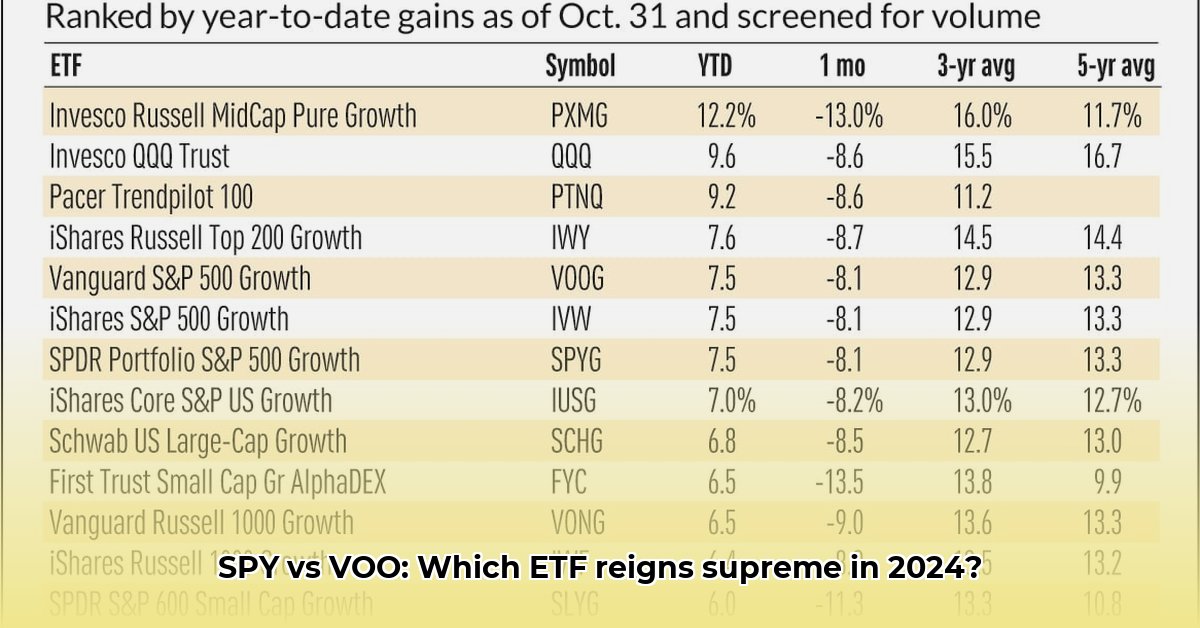
Understanding the S&P 500 Growth ETF Showdown
Choosing between SPYG (SPDR Portfolio S&P 500 Growth ETF) and VOOG (Vanguard S&P 500 Growth ETF) presents a nuanced challenge for investors. Both ETFs track the S&P 500 Growth Index, aiming to replicate the performance of large-cap growth stocks. However, subtle but significant differences in expense ratios, historical maximum drawdowns, and dividend yields exist, impacting long-term returns and risk profiles. This comparative review will analyze these differences to help investors make informed decisions. Isn't understanding the nuances of these seemingly similar ETFs crucial for optimizing investment strategies?
Comparative Analysis: Key Metrics and Implications
The following table presents a head-to-head comparison of key metrics for SPYG and VOOG:
| Feature | SPYG | VOOG | Implication |
|---|---|---|---|
| Expense Ratio | 0.04% | 0.10% | SPYG's lower expense ratio translates to significantly higher long-term returns. |
| 10-Year Annualized Return | ~15.36% | ~15.32% | Virtually identical historical returns. |
| YTD Annualized Return | ~4.04% | ~4.14% | Minor difference; not significantly conclusive for long-term projections. |
| Maximum Drawdown | -67.79% | -32.73% | SPYG exhibits substantially higher volatility and risk. |
| Volatility | 6.10% | 6.10% | Similar volatility despite differing maximum drawdowns. |
| Sharpe Ratio | 1.71 | 1.71 | Similar risk-adjusted returns. |
| Dividend Yield | 0.58% | 0.47% | SPYG offers a slightly higher, albeit modest, dividend income stream. |
Note: Past performance doesn't guarantee future results. These figures are for illustrative purposes only.
Nuanced Points: Drawdowns, Expenses, and Diversification
The stark difference in maximum drawdown between SPYG (-67.79%) and VOOG (-32.73%) is noteworthy. While both ETFs track the same index, SPYG's history suggests a greater susceptibility to market downturns. This is a crucial factor for investors with varying risk tolerances. A risk-averse investor might prioritize VOOG's smoother historical performance. However, over the long term, the compounding effect of SPYG's lower expense ratio could outweigh its higher drawdown risk for investors with a longer time horizon and higher risk tolerance.
The high correlation between SPYG and VOOG's performance underscores the importance of diversification. Holding both ETFs doesn't significantly reduce portfolio risk; instead, it might amplify the impact of market fluctuations. Diversifying across various asset classes is critical to mitigate risk effectively.
Actionable Recommendations: Tailoring to Investor Profiles
The optimal choice (SPYG or VOOG) depends on individual circumstances.
Individual Investors: Consider your risk tolerance and investment horizon. Long-term investors might favor SPYG's lower expense ratio, while risk-averse investors may prefer VOOG's stability.
Financial Advisors: Construct diversified portfolios integrating both ETFs, but tailor allocations based on client-specific risk profiles and investment objectives. Remember to emphasize the importance of diversification across various asset classes.
Institutional Investors: Carefully weigh the long-term cost savings of SPYG's lower expense ratio against the potential for higher drawdowns. Consider the impact on overall portfolio performance and risk management.
Risk Assessment and Regulatory Details
Investing inherently involves risk. The value of investments can fluctuate, potentially resulting in losses. Stay informed about regulatory changes that could affect the ETF market. The information provided here is for educational purposes only and should not be construed as financial advice. Consult with a qualified financial advisor before making any investment decisions.
Conclusion: A Strategic Choice, Not a Binary Decision
The selection between SPYG and VOOG demands a thorough understanding of one's risk tolerance, investment timeframe, and overall portfolio strategy. Both ETFs offer exposure to the S&P 500 Growth Index, but their risk-return profiles differ subtly. A careful assessment of expense ratios, maximum drawdowns, and dividend yields, coupled with a focus on diversification, is crucial for making an informed investment decision.